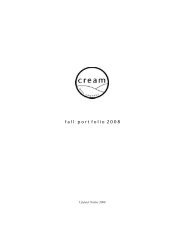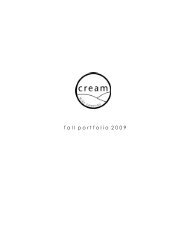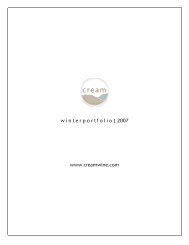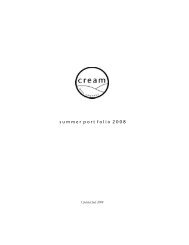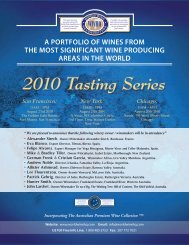âWhy don't you call me sometime when you have no class ...
âWhy don't you call me sometime when you have no class ...
âWhy don't you call me sometime when you have no class ...
You also want an ePaper? Increase the reach of your titles
YUMPU automatically turns print PDFs into web optimized ePapers that Google loves.
FRESH CREAM! SEPTEMBER 2006 NEWSLETTER<br />
JON-DAVID HEADRICK SELECTIONS – Charlotte, NC<br />
People: Jon-David Headrick<br />
Website: http://www.jondavidwines.com<br />
Focus: Naturally far<strong>me</strong>d Loire and Grower Champagne<br />
Brands Represented by Cream: Champagne Francoise Bedel et Fils, Champagne Franck Pascal, Champagne Tarlant, Domaine<br />
Benedicte de Rycke, Domaine Damien Laureau, Domaine de la Noblaie, Domaine des Huards, Domaine des Roches Neuves,<br />
Domaine Frederic Mabileau, Domaine Laurent Chatenay, Domaine Vincent Ogereau, Domaine Saint Nicolas, Domaine du Viking,<br />
Jean-Francois Merieau, La Craie, La Tour St. Martin, Le Paradou<br />
Cream Wine Company is thrilled to represent the properties of Jon-David Headrick Selections. When we asked<br />
Jon-David contribute so<strong>me</strong> portfolio ‘kick off text’, he wrote: “Standing in a rocky, chalk-covered vineyard in Sancerre<br />
a few years ago, I listened as a winegrower friend talked about the current state of wine. “Fruit in a wine is<br />
easy”, he said. “Purity is elusive. Purity co<strong>me</strong>s from the struggle of the vine through the rocks it is planted on, the<br />
fight against every other plant in the vineyard vying for the sa<strong>me</strong> water and nutrients, and <strong>no</strong> interference from<br />
man. Leave fruit for beginners. You should look for purity.”<br />
As an A<strong>me</strong>rican who was also wine drinker, it took so<strong>me</strong> ti<strong>me</strong> for this concept to sink in. We are used to drinkingwine<br />
that is described by writers as “gobs of juicy raspberry fruit” or “dense spicy blackberry”. These appeal toour<br />
opulent, hedonistic side. But after a while, I wanted so<strong>me</strong>thing more and started seeking out wines that matched<br />
the description of my winemaker friend. What I found was that this is more easily achieved in areas where the vine<br />
has to struggle with climatic conditions that are <strong>no</strong>t ideal (less sun, for starters) and made by people who allow the<br />
vine to grow naturally with little or <strong>no</strong> intervention. In creating this portfolio, I was looking for these kinds of<br />
wines, and I found them planted on a massive swath of chalk and slate that runs from the Atlantic ocean through<br />
the Loire river valley and into Champagne. I <strong>call</strong> this rocky band that stretches for about 600 kilo<strong>me</strong>ters “The<br />
Chalk Line”. Started in 2003, my portfolio of small wineries from Northern France focuses on this chalk line and<br />
currently includes 15 properties from the Loire and 5 growers from Champagne. In Champagne, I work only with<br />
growers, never negociants. I’m only interested in people who grow and bottle their own wines. This approach allows<br />
for more place specificity. The purity that I <strong>me</strong>ntioned earlier is completely obliterated by blending various<br />
parcels from vastly different winegrowing areas, so I look for growers who vinify and bottle by parcel and who use<br />
extre<strong>me</strong>ly low dosages. Many of the Champagnes I work with <strong>have</strong> <strong>no</strong> dosage added (<strong>call</strong>ed in French “Brut<br />
Zero”). No dosage simply <strong>me</strong>ans that <strong>you</strong> taste only what is in the vineyard.<br />
In the Loire, I <strong>have</strong> taken a Burgundian approach and am assembling a portfolio that represents a comprehensive<br />
look at the valley, <strong>no</strong>t just the k<strong>no</strong>wn categories such as Sancerre and Muscadet. Growing regions such as the Fiefs<br />
Vendéens and Jasnieres, seldom seen here in the United States, figure prominently in my book. With Chenin<br />
Blanc, in particular, I <strong>have</strong> sought out examples of the varietal planted on a variety of soil types from chalk, slate,<br />
sand, gravel, silex, etc. in an attempt to show what an amazing varietal the grape is. The sa<strong>me</strong> grape, harvested in<br />
the sa<strong>me</strong> vintage, tastes completely different depending on what side of the river it is on. The properties with<br />
which I work are consu<strong>me</strong>d with making “true” wines, wines which are true to where they co<strong>me</strong> from, true to the<br />
earth, and true to the winemaker’s obsession with quality. The wines are harvested by hand and the grapes are<br />
grown according to either organic or biodynamic practices. Many of the properties are certified organic or biodynamic.<br />
All are leaders in their appellations and harvest lower yields than their neighbors to ensure a premium product.<br />
Above anything else, they are far<strong>me</strong>rs, and they understand that wine is made in the vineyard, <strong>no</strong>t the winery.<br />
In selecting properties for the portfolio, I seek purity first, eschewing heavy-handed usage of oak and opting instead<br />
for wines of excellent ripeness, minerality, and above all, balance. The presence of balanced acidity is absolutely<br />
crucial in my view to world-<strong>class</strong> wine, and I’m <strong>no</strong>t afraid to represent wines that <strong>have</strong> startling acidity if<br />
there is fruit to support it.” ~Jon-David Headrick<br />
Cream Wine Company | 118 N. Peoria Street Chicago IL 60607 | Tel 312 421 1900 | Fax 312 421 1977 | service@creamwine.com



